Heinz Guderian
| Heinz Guderian | |
|---|---|
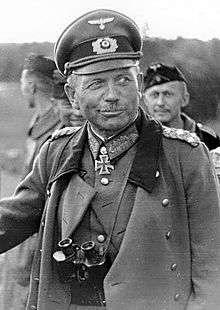 Guderian on the Eastern Front, July 1941 | |
| Nickname(s) |
Schneller Heinz (Hurrying Heinz) Hammering Heinz[1] |
| Born |
17 June 1888 Kulm, Kingdom of Prussia, German Empire (now Poland) |
| Died |
14 May 1954 (aged 65) Schwangau, Bavaria, West Germany |
| Allegiance |
|
| Years of service | 1907–1945 |
| Rank | Generaloberst |
| Commands held |
2nd Panzer Division XVI Army Corps XIX Army Corps 2nd Panzer Army |
| Battles/wars | |
| Awards | Knight's Cross of the Iron Cross with Oak Leaves |
| Relations | Heinz-Günther Guderian (son) |
Heinz Wilhelm Guderian (German: [ɡuˈdeːʁi̯an]; 17 June 1888 – 14 May 1954) was a German general during the Nazi era. An early pioneer and advocate of the "blitzkrieg" (lightning war) doctrine, he successfully led Panzer (armoured) units during the Invasion of Poland, the Battle of France, and Operation Barbarossa, the invasion of the Soviet Union.
Guderian had developed motorized tactics in the pre-war army, while keeping himself well-educated about armored formations in other armies. In particular, he implemented the use of radio communication between tank crews and devised shock tactics that proved highly effective. In May 1940, he commanded the Panzer divisions that overwhelmed the French defences at Sedan, France, leading to the surrender of France a month later. After the German defeat at the Battle of Moscow in December 1941 he was transferred to reserve.
After the defeat at Stalingrad in early 1943, Hitler appointed him to a new position, rebuilding the Panzer forces, but he bickered with many other generals, who managed to get his duties re-allocated. He was then appointed Chief of the General Staff of the Army in July 1944, but this was largely a symbolic role since Hitler had effectively become his own Chief of Staff. Guderian was dismissed in March 1945. From 1945-48, Guderian was held in U.S. custody, but released without charge. He later served as an advisor overseeing the establishment of the military in West Germany. Guderian died in 1954.
Early life and World War I
Guderian was born in Kulm, West Prussia (now Poland), the son of Friedrich Guderian and Clara (née Kirchoff).[2][3] He entered the Army in 1907. On 1 October 1913, he married Margarete Goerne, with whom he had two sons, Heinz Günther (2 August 1914 – 2004) and Kurt (17 September 1918 – 1984).
At the outset of World War I Guderian served as a Signals Officer in the 5th Cavalry Division. On 28 February 1918 Guderian was appointed to the General Staff Corps.[4] Like many Germans, he disagreed with Germany signing the armistice in 1918, believing the German Empire should have continued the fight.[5]
Interwar period
Early in 1919, Guderian was selected as one of the four thousand officers to continue on in military service for the reduced size German army, the Reichswehr. He was assigned to serve on the staff of the central command of the Eastern Frontier Guard Service. This Guard Service was intended to control and coordinate the independent Freikorps units in the defense of Germany's eastern frontiers against Polish and Soviet forces engaged in the Russian Civil War.[6] In June 1919, Guderian joined the Iron Brigade (later known as the Iron Division) as its second General Staff officer.[7] The commanders of the regular German army had intended that this move would allow the army to reassert its control over the Iron Division; however, their hopes were disappointed. Rather than restrain the Freikorps, Guderian's anti-communism caused him to empathize with the Iron Division's efforts to defend Prussia against the Soviet threat. The Iron Division waged a ruthless campaign in Lithuania and pushed into Latvia; however, traditional German anti-Slavic attitudes prevented the division's full cooperation with the White Russian and Baltic forces opposing the Bolsheviks.[8]
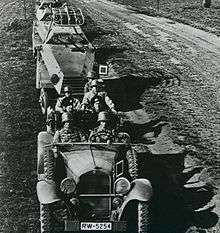
Guderian was assigned as a company commander for the 10th Jäger-Battalion. Later he joined the Truppenamt ("Troop Office"), which was a clandestine form of the Army's General Staff which had been officially forbidden by the Treaty of Versailles. In 1927 Guderian was promoted to major and transferred to the command of Army transport and motorized tactics in Berlin. This placed Guderian at the center of German development of armoured forces. Guderian, who was fluent in both English and French, studied the works of British maneuver warfare theorists J. F. C. Fuller, Giffard Martel and B.H. Liddell Hart. In 1931, he was promoted to Oberstleutnant (Lieutenant-Colonel) and became chief of staff to the Inspectorate of Motorized Troops under Oswald Lutz. In 1933 he was promoted to Oberst or Colonel.
Guderian wrote many papers on mechanized warfare during this period. These papers were based on extensive study of the lessons of the First World War, research on foreign literature on the use of armour, and wargaming done with dummy tanks and later with early armoured vehicles. Some of these trial maneuveres were conducted in the Soviet Union. Britain at this time was experimenting with tanks under General Hobart, and Guderian kept abreast of Hobart's writings using, at his own expense, someone to translate all the articles being published in Britain.[9]
In October 1935 he was made commander of the newly created 2nd Panzer Division (one of three). On 1 August 1936 he was promoted to Generalmajor, and on 4 February 1938 he was promoted to Generalleutnant and given command of the XVI Army Corps.[10]
In 1936, General Lutz asked Guderian to write a book on the developing panzer arm and the theories that had been developed on its use in war.[11] The resulting volume, Achtung - Panzer!, was his most important work. It reviewed the state of armoured development in the European nations and Soviet Russia, and presented Guderian's theories on the effective use of armoured formations and combined-arms warfare ideas of other general staff officers. The book included the importance of airpower in support of the panzer units for future ground combat.
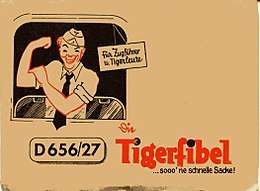
Germany's panzer forces were created largely along the lines laid down by Guderian in his book.
Mobile warfare
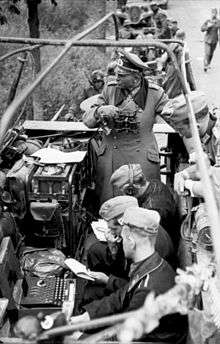
Toward the end of World War I, the German army developed infiltration tactics — breaking through a defensive trench line with special combat teams of sturmtruppen, who advanced in dispersed order rather than massed rushes, and bypassed strong points to attack rear areas to collapse enemy positions. This method was used in the 1918 German Spring Offensive, but the German forces lacked the mobility to exploit breakthroughs and achieve deep penetrations of the enemy defenses. They were unable to sustain the impetus of the initial attack, and ultimately they failed to gain decisive results.
Motorized troops were the key to sustaining a breakthrough, and until the 1920s the extent of motorization necessary was not possible. Soviet marshal Mikhail Tukhachevsky pursued the idea, but he was executed in 1937 in Stalin's "Great Purge" of Soviet military leaders.
Guderian was the leading advocate in Germany of motorization and tanks, and of using armored forces in deep penetration operations. He is regarded as the chief architect of Germany's panzer divisions.
Guderian developed and advocated the strategy of concentrating panzer ("armored") formations at the point of attack (the Schwerpunkt) and deep penetration. In Achtung Panzer, he described what he believed were essential elements for a successful panzer attack: surprise, deployment in mass, and suitable terrain.[12] He proposed armored divisions in which motorized infantry and artillery would operate in conjunction with tanks to achieve a decisive success. In his memoir Panzer Leader, he wrote that as early as 1929, he "became convinced that [...] it would be wrong to include tanks in infantry divisions: what were needed were armored divisions which would include all the supporting arms needed to fight with full effect."[13] After Hitler came to power and Germany began re-arming, Guderian was empowered to put his ideas into practice.
Guderian believed that among those things needed for success was for commanders of mobile forces to be able to communicate with each other and their sub-units. Guderian insisted in 1933 that German tanks be equipped with radios and intercoms (throat microphones) to enable each tank commander to communicate with his crew and with other tanks in his platoon and company.[14] In each individual German tank, the tank crew worked as a team, and the tank commander could communicate with each crew member. Moreover, German tanks worked collectively as teams, providing mutual protection and increased effective firepower.[15] Said Hermann Balck: "The decisive breakthrough into modern military thinking came with Guderian, and it came not only in armor, but in communication."[16] Of Guderian's contributions, Balck considered some of the most important to be the five man tank crew, with a dedicated radio operator in the hull of the tank, and the organization of divisional signals troops to allow the commander to direct the division from any unit. This allowed forward control of the division, which was critical to mobile warfare.[17] The German victories from 1939 through 1941 were not due to superior equipment, but to superior tactics in the use of that equipment, and superior command and control which allowed the German panzer forces to operate at a much faster pace.
Second World War
Invasion of Poland
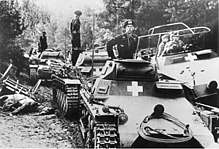
Guderian led the XIX Corps during the invasion of Poland. This corps comprised a panzer division and two motorized infantry divisions. Guderian led his corps in the Battle of Wizna and the Battle of Kobryn. In each of these, he abandoned his theories of rapid manoeuvre and was highly successful using tanks to deliver offensive sapper companies that successfully blew up the majority of the Polish bunkers at Wizna. He showed great political astuteness in the battle of Kobryn by passing the initiative to the Soviets.
Following the completion of the campaign in Poland the armoured forces were transferred to the west to prepare for the next set of operations. The four light divisions had proved to have inadequate firepower, and they were brought up to strength to full panzer divisions, one of which was given to Erwin Rommel. With this change, the total number of panzer divisions in the Heer stood at ten. Guderian continued to work in the development of the Panzerwaffe ("panzer arm").
Invasion of France and the Low Countries (1940)
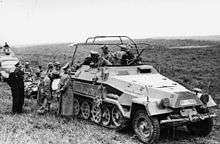
In the planning for the Invasion of France, Guderian supported the change in the attack plan from a massive headlong invasion through the Low Countries to the Manstein Plan, which shifted the weight of the armoured formations to the Ardennes. Guderian's corps spearheaded the drive and passed through the Ardennes and over the Meuse in three days. He led the attack that broke the French lines at Sedan, resulting in a general collapse of the French defenses. His guidance of the panzer formations earned him the nickname "Der schnelle Heinz" (Fast Heinz).[18] Guderian's panzer group led the "race to the sea" that split the Allied armies in two, depriving the French armies and the BEF in Northern France and Belgium of their fuel, food, spare parts and ammunition. Faced with orders from nervous superiors to halt on one occasion, he managed to continue his advance by stating he was performing a "reconnaissance in force", but the German High Command ultimately denied him the authority to attack the Allied forces encircled in the pocket at Dunkirk.
Invasion of the Soviet Union
In 1941 Guderian commanded the 2nd Panzer Group, also known as Panzergruppe Guderian, during Operation Barbarossa, the German invasion of the Soviet Union. The unit later was redesignated 2nd Panzer Army. He became the 24th recipient of the Oak Leaves to his previously-awarded Knight's Cross of the Iron Cross on 17 July of that year after his armored spearhead captured Smolensk. Guderian's panzer group was ordered to turn south in an effort to encircle the Soviet forces to the south.
Following the completion of the encirclement in the Battle of Kiev, Guderian was ordered to make a drive for Moscow in mid-September 1941.[19] In November, the attack by the 2nd Panzer Group on Tula and Kashira, 125 km (78 mi) south of Moscow, achieved only fleeting and precarious success, while Guderian vacillated between despair and optimism, depending on the situation at the front.[20] Facing pressure from the German High Command, Kluge finally committed his weaker south flank to the attack on 1 December. In the aftermath of the battle, Hoepner and Guderian blamed slow commitment of the south flank of the 4th Army to the attack for the German failure to reach Moscow. Stahel wrote that this assessment grossly overestimated the capabilities of Kluge’s remaining forces.[21] It also failed to appreciate the reality that Moscow was a metropolis that German forces lacked the numbers to encircle. With the outer defensive belt completed by 25 November, Moscow was a fortified position which the Wehrmacht lacked the strength to take in a frontal assault either.[22]
In the face of the Soviet counter-offensive, Guderian was not allowed to pull his forces back but instead was ordered to "stand fast", keeping them all in their current positions. He disputed that order, going personally to Adolf Hitler's headquarters, but it was not changed. After returning to his command, Guderian carried out a series of withdrawals anyway, directly disobeying his orders. A heated series of disputes with Field Marshal Günther von Kluge, the commander of Army Group Centre, then followed. Guderian was relieved of command on 26 December 1941, along with 40 other generals. He was transferred to the reserve pool. Guderian held hard feelings on the matter against Kluge, who he felt had failed to support him.
Inspector General of Armoured Troops
After the German defeat at Stalingrad, Hitler realized he needed Guderian's expertise. He personally requested Guderian to take a new position as "Inspector General of Armoured Troops". Guderian made a number of stipulations to ensure that he would have the requisite authority to perform his duties. Hitler agreed to these conditions, and on 1 March 1943 he was appointed to the newly created position. His responsibilities were to oversee the rebuilding of the greatly weakened panzer arm, to oversee tank design and production, and the training of Germany's panzer forces, and he was to advise Hitler on their use. His new position allowed him to bypass much of the Nazi bureaucracy and report to Hitler directly.
Guderian was opposed by a number of officers in the Wehrmacht who did not want to see the scope of their own power and influence curtailed. Said Hermann Balck, who had worked with Guderian at the Inspectorate of Mobile Troops: "Guderian was always in conflict with everybody else. He was very hard to get along with, and it's a tribute to the German Army, as well as to Guderian's own remarkable abilities, that he was able to rise as high as he did within the German Army."[16] The primary area of resistance to Guderian came from the artillery branch.[23] In an effort to curtail Guderian's influence, an adjective was added to his areas of oversight, changing the term "assault guns", which was becoming an increasingly important source of firepower for the panzer divisions, to "heavy assault guns", which was far more limited. The qualifier removed the Stug III, Wespe and Hummel from Guderian's authority, meaning that 90% of assault gun production, training and use would be beyond his influence.[24]
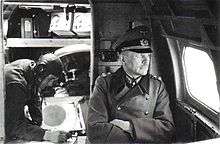
Operation Citadel, the last major German offensive operation in the east, was an attempt by the German army to regain the initiative. The plans of the operation were known to the Soviet defenders, who spent months building up a defense in depth to sap the strength of the attacking panzer units. The operation violated two of the three tenets for successful tank operations that Guderian had laid out in Achtung – Panzer!, namely that terrain for the operation had to be chosen that was open, and not built up with heavy defenses. Secondly, and more importantly, the strike had to be delivered in a manner that took the defenders by surprise. In light of the obvious heavy defenses the Soviets had been preparing for the attack, the operation was a clear misuse of the Panzerwaffe. The result would be a significant weakening of German panzer forces, forces that Guderian had been trying to rebuild. In a conversation with Hitler on 14 May 1943, Guderian pointed out the futility of the operation, asking, "My Führer, why do you want to attack in the East at all this year?" Hitler responded, "You are quite right. Whenever I think of this attack my stomach turns over." Guderian concluded, "In that case your reaction to the problem is the correct one. Leave it alone."[25]
When General Wilhelm Keitel, the head of the OKW, explained the political importance of the offensive, Guderian remarked, "How many people do you think even know where Kursk is? It's a matter of profound indifference to the world whether we hold Kursk or not..."[26]
The attack, originally planned to begin in May, was delayed until July. It went on for a week before Soviet pressures on the Orel salient to the north and the necessity to respond to the allied invasion of Sicily resulted in the operation being halted. The Soviets then seized the initiative, which they held for the remainder of the war.
In his role as Inspector General of Armoured Troops, Guderian observed that Hitler was prone to experiment with too many designs, rather than finding an effective design and produce it in large numbers. He believed this resulted in logistical and repair problems for German forces in the Soviet Union.[27] Guderian would have preferred the production of larger numbers of Panzer IVs and Panthers, and less effort spent on such projects as the Jagdtiger, the Panzer VIII Maus super tank, and the Schwerer Gustav 800 mm railway gun.
On 21 July 1944, after the failure of the 20 July Plot to assassinate Hitler, in which Guderian had no direct involvement, Guderian was appointed Chief of Staff of the Army (Chef des Generalstabs des Heeres) succeeding Kurt Zeitzler who had departed on 1 July after multiple conflicts with Adolf Hitler.
Later life and death
Guderian and his staff surrendered to U.S. forces on 10 May 1945. He remained as a prisoner of war in U.S. custody until his release on 17 June 1948. His conduct was investigated and no charges were brought. After the war he was often invited to attend meetings of British veterans' groups, where he analyzed past battles with his old foes. During the early 1950s Guderian was among the military advisors who helped in the establishment of West Germany's military defence force, the Bundeswehr, which has gone on to be the military defence force of Germany today.
Guderian died on 14 May 1954 at the age of 65, in Schwangau near Füssen in (Southern Bavaria) and is buried at the Friedhof Hildesheimer Straße in Goslar.
A documentary about his life aired on French television in 2000. Titled Guderian, it was directed by Anton Vassil and featured Guderian's son Heinz-Günther, Field Marshal Lord Carver and historians Kenneth Macksey and Heinz Wilhelm.
Appropriation of Polish estate
After the invasion of Poland, a large number of estates were seized by the German government. Hitler attempted to engender loyalty in key commanders by offering them financial gifts. Following his success in Poland Guderian was given 2,000 acres (810 ha) at Deipenhof (now Głębokie) in the Warthegau area of occupied Poland. The occupants were evicted.[28] Guderian told Erich von Manstein that he was given a list of Polish estates that he studied for a few days before deciding which to claim for his own. After the war Guderian changed the dates and circumstances of the situation in his memoirs to present the takeover of the estate as a legitimate retirement gift.[29][30]
Awards
- Iron Cross (1914) 2nd Class (17 September 1914) & 1st Class (8 November 1916)[31]
- Knight 2nd class of the Friedrich Order with Swords (Württemberg) (15 December 1915)[31]
- Saxe-Ernestine House Order Commander 2nd Class with Swords (1 July 1935)[31]
- Royal Hungarian War Memorial Medal with Swords (14 January 1937)[31]
- War Memorial Medal with Swords (Austria) (9 March 1937)[32]
- Order of St. Sava 1st Class (21 November 1939)[32]
- Clasp to the Iron Cross (1939) 2nd Class (5 September 1939) & 1st Class (13 September 1939)[31]
- Knight's Cross of the Iron Cross with Oak Leaves
- Knight's Cross on 27 October 1939 as General der Panzertruppe and commander of the XIX Army Corps[33]
- 24th Oak Leaves on 17 July 1941 as Generaloberst and commander of 2nd Panzer Group[34]
Works
- Guderian, Heinz (1937). Achtung - Panzer! (reissue ed.). Sterling Press. ISBN 0-304-35285-3. Guderian reviews the development of armoured forces in the European nations and Soviet Russia, and describes what he felt was essential for the effective use of armoured forces.
- Guderian, Heinz (1942). Mit Den Panzern in Ost und West. Volk & Reich Verlag.
- Guderian, Heinz (1950). Kann Westeuropa verteidigt werden?. Plesse-Verlag.
- Guderian, Heinz (1952). Panzer Leader. Da Capo Press Reissue edition, 2001. New York: Da Capo Press. ISBN 0-306-81101-4. Guderian describes his time as an officer in charge of various German armoured forces. Originally published in German, titled Erinnerungen eines Soldaten (Memories of a Soldier) (Kurt Vowinckel Verlag, Heidelberg 1950; 10th edition 1977).
See also
References
Citations
- ↑ Boot 2006, p. 223.
- ↑ Guderian 1937, p. 7.
- ↑ Frank N. Magill (5 March 2014). The 20th Century Go-N: Dictionary of World Biography. Routledge. pp. 1490–. ISBN 978-1-317-74060-5.
- ↑ Barnett 1989, p. 442.
- ↑ Hargreaves 2009, p. 29.
- ↑ Hart 2006, p. 16.
- ↑ Hart 2006, p. 17.
- ↑ Hart 2006, p. 18.
- ↑ Shepperd 1990, pp. 10–11.
- ↑ Guderian 1952, p. 47.
- ↑ Zimmer 2013, p. 13.
- ↑ Guderian 1937, p. 205.
- ↑ Guderian 1952, p. 15.
- ↑ Zimmer 2013, p. 12.
- ↑ Guderian 1952, p. 20.
- 1 2 Balck 2000, p. 17.
- ↑ Balck 2000, p. 18.
- ↑ Guderian 1952, p. 108.
- ↑ Barnett 1989, p. 453.
- ↑ Stahel 2015, p. 186−189, 228.
- ↑ Stahel 2015, pp. 229–230.
- ↑ Stahel 2015, pp. 235–237, 250.
- ↑ Balck 2000, p. 31.
- ↑ Clark 1965, p. 313.
- ↑ Healy, p. 23
- ↑ Clark 1965, p. 325.
- ↑ Guderian 1952.
- ↑ James V. Koch, review Archived 2005-03-06 at the Wayback Machine. of Guderian: Panzer General by Kenneth Macksey
- ↑ Kreike & Jordan 2004, p. 123.
- ↑ Beevor 2002, p. 13.
- 1 2 3 4 5 Wegmann 2009, p. 204.
- 1 2 Wegmann 2009, p. 205.
- ↑ Fellgiebel 2000, p. 171.
- ↑ Fellgiebel 2000, p. 50.
Bibliography
- Balck, Hermann (2000). General Hermann Balck : an interview 12 January 1979. Bennington, Vermont: Merriam Press.
- Beevor, Antony (2002). Berlin: The Downfall 1945. Viking-Penguin Books. ISBN 978-0-670-03041-5.
- Boot, Max (2006). War made new: technology, warfare, and the course of history, 1500 to today. New York: Gotham Books. ISBN 9781592402229. LCCN 2006015518.
- Clark, Alan (1965). Barbarossa: The Russian-German Conflict 1941-45. New York: HarpersCollins. ISBN 978-0-688-04268-4.
- Fellgiebel, Walther-Peer (2000) [1986]. Die Träger des Ritterkreuzes des Eisernen Kreuzes 1939–1945 — Die Inhaber der höchsten Auszeichnung des Zweiten Weltkrieges aller Wehrmachtteile [The Bearers of the Knight's Cross of the Iron Cross 1939–1945 — The Owners of the Highest Award of the Second World War of all Wehrmacht Branches] (in German). Friedberg, Germany: Podzun-Pallas. ISBN 978-3-7909-0284-6.
- Barnett, Correlli, ed. (1989). Hitler's Generals. Weidenfeld and Nicolson. ISBN 0-297-79462-0.
- Guderian, Heinz (1937). Achtung - Panzer!. Sterling Press. ISBN 0-304-35285-3.
- Guderian, Heinz (1952). Panzer Leader. New York: Da Capo. ISBN 0-306-81101-4.
- Hargreaves, Richard (2009). Blitzkrieg w Polsce wrzesien 1939. Warsaw: Bellona.
- Hart, Russell A. (2006). Guderian: Panzer pioneer or myth maker?. Washington, D.C.: Potomac Books. ISBN 978-1-59797-453-0.
- Kreike, Emmanuel; Jordan, William Chester (2004). Corrupt Histories. Rochester, NY: University of Rochester Press. ISBN 978-1-58046-173-3.
- Luck, Hans von (1989). Panzer Commander: The Memoirs of Colonel Hans von Luck. Cassel Military Paperbacks. ISBN 0-304-36401-0.
- Rommel, Erwin (1982) [1953]. Liddell Hart, B. H., ed. The Rommel Papers. New York: Da Capo Press. ISBN 978-0-306-80157-0.
- Shepperd, Alan (1990). France, 1940: Blitzkrieg in the West. Oxford, UK: Osprey Publishing. ISBN 978-0-85045-958-6.
- Stahel, David (2015). The Battle for Moscow. Cambridge: Cambridge University Press. ISBN 978-1-107-08760-6.
- Thomas, Franz (1997). Die Eichenlaubträger 1939–1945 Band 1: A–K [The Oak Leaves Bearers 1939–1945 Volume 1: A–K] (in German). Osnabrück, Germany: Biblio-Verlag. ISBN 978-3-7648-2299-6.
- Wegmann, Günter (2009). Die Ritterkreuzträger der Deutschen Wehrmacht 1939–1945 Teil VIIIa: Panzertruppe Band 2: F–H [The Knight's Cross Bearers of the German Wehrmacht 1939–1945 Part VIIIa: Panzer Force Volume 2: F–H] (in German). Bissendorf, Germany: Biblio-Verlag. ISBN 978-3-7648-2389-4.
- Williamson, Gordon; Ramiro Bujeiro (2004). Knight's Cross and Oak-Leaves Recipients 1939–40: Knight's Cross and Oakleaves,1939–40. ISBN 1-84176-641-0.
- Young, Desmond (1950). Rommel The Desert Fox. New York: Harper & Row. OCLC 48067797.
- Zimmer, Phil (October 2013). "Blitzkrieg Author". World War II History. XII (6): 10–15.
Further reading
- Corum, James (1992). The Roots of Blitzkrieg. University Press of Kansas. ISBN 070060541X.
- Kershaw, Ian, Hitler 1936–1945: Nemesis (2001)
- Macksey, Kenneth, Guderian: Panzer General (1992, revision of Guderian, Creator of the Blitzkrieg, 1976)
- Pöhlmann, Markus (2016). Der Panzer und die Mechanisierung des Krieges: Eine deutsche Geschichte 1890 bis 1945. Paderborn: Ferdinand Schöningh. ISBN 978-3-506-78355-4.
- Searle, Alaric (2003). Wehrmacht Generals, West German Society, and the Debate on Rearmament, 1949–1959. Westport, CT: Praeger Publishers. ISBN 978-0-275-97968-3.
- Walde, Karl J., Guderian (1978) ISBN 3550073437
External links
- Heinz Guderian in the German National Library catalogue
- Personality Profile - General Heinz Guderian by the Journal of the Singapore Armed Forces
- Cold Start Doctrine - Offshoot of Guderian's Concepts Pakistan Today
- Works by or about Heinz Guderian at Internet Archive
| Military offices | ||
|---|---|---|
| Preceded by — |
Commander of 2. Panzer-Armee 5 October 1941 – 25 December 1941 |
Succeeded by Generaloberst Rudolf Schmidt |
| Preceded by Kurt Zeitzler |
Chief of Staff of the OKH July 1944 – March 1945 |
Succeeded by Hans Krebs |
| Awards and achievements | ||
| Preceded by Alexander Novikov |
Cover of Time Magazine 7 August 1944 |
Succeeded by Sir Arthur Coningham |